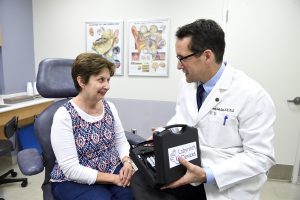“I credit Dr. Della Santina for giving me my life back. … I wanted to help him help others. Because of Dr. Della Santina, I haven’t had a vertigo attack in four years. It’s the greatest thing in the world.”
Les Sorensen Grateful patient and donor
Les Sorensen knew he had Ménière’s Disease — a disorder of the inner ear that causes severe balance and hearing issues. But he didn’t know why the therapies he’d used for years weren’t working anymore. As his symptoms worsened to the point that he felt uncomfortable driving, he began working with Charles Della Santina, a professor of otolaryngology-head and neck surgery at Johns Hopkins. Over time, Della Santina and his colleagues identified a combination of medication and dietary restrictions that helped Sorensen regain stable vision and balance.
“I credit Dr. Della Santina for giving me my life back,” Sorensen says.
Yet many patients suffering from Ménière’s and other vestibular disorders find few answers when medications and physical therapy fail. When Sorensen learned that Della Santina was developing a vestibular implant to help these patients, he immediately wanted to support the research.
“I wanted to help him help others,” Sorensen says. “Because of Dr. Della Santina, I haven’t had a vertigo attack in four years. It’s the greatest thing in the world.”
Vestibular sensation is one of the functions of the inner ear, helping a person know which way is up and which is down. It also controls muscles that stabilize the eyes so vision doesn’t blur each time the head moves or bounce with the beat of one’s pulse. When vestibular function fails, the world looks like it’s constantly moving, leading to side effects like motion sickness and difficulty walking without falling.
“Most of my patients are able to work around it, but even some who seem to be doing OK are doing so at the expense of the significant cognitive effort it takes to do things that ought to be automatic,” Della Santina says.
About 15 years ago, Della Santina and some colleagues hypothesized that the cochlear implant — a device that helps restore hearing and has been widely used since the 1970s — could be adapted to help restore vestibular sensation.
“I credit Dr. Della Santina for giving me my life back. … I wanted to help him help others. Because of Dr. Della Santina, I haven’t had a vertigo attack in four years. It’s the greatest thing in the world.”
Les Sorensen Grateful patient and donor
Della Santina’s device uses a motion sensor in place of the cochlear implant’s microphone and attaches a stimulator to the vestibular nerve branches in the inner ear’s labyrinth instead of the cochlea. The stimulator tells the brain how fast the sensor is moving in every direction.

“When implanted patients move their heads, they now have a signal from their ear telling the brain ‘You’re moving your head: keep your eyes on target and turn on the reflexes you need to keep from falling down,'” Della Santina explains.
After more than a decade of development, Della Santina’s Vestibular NeuroEngineering Laboratory (VNEL) at Hopkins and start-up company, Labyrinth Devices, secured approval for a first-in-human trial of a Multichannel Vestibular Implant (MVI) based on VNEL technology in 2016. Three subjects have been implanted with the device, and Della Santina shared some early results from the trial at a July 2017 American Cochlear Implant Alliance Conference in San Francisco. One particular anecdote from the trial, he says, stands out.
“The FDA originally required that we only let each subject use the device for two months, but all three of our participants wanted to keep using it,” Della Santina says. The team solicited the FDA’s approval for extended use, and after the third subject joined the request, the agency granted it for all future subjects.
Although National Institutes of Health (NIH) and industry funding played the most significant role in supporting the MVI’s development, philanthropy — including Sorenson’s support — has been indispensable. It’s given Della Santina flexibility to bring on students and postdoctoral researchers whose work accelerates science crucial to guiding design of the next stage of a trial. It’s also key to keeping a core team of researchers together for the time necessary to bring a medical innovation to market, particularly in between grant cycles.
“We’re in the final year of our grant support for the clinical trial, so in the next six months, I’ll need to find support to keep our clinical research, basic science and engineering teams together,” Della Santina says, noting that several of his staff have caught the eye of competitor institutions. “An endowed lab would give us strong foundation to keep this work going as quickly as possible.”
Donors like Sorensen are also important because they serve as evangelists for work Hopkins researchers are pursuing. And that’s a role Sorensen’s proud to play on Della Santina’s behalf.
“There are so many people who have these dreadful, debilitating conditions who could possibly be helped by Dr. Della Santina’s work,” Sorensen says. “I’m fortunate to be in a position to support him.”
Topics: Friends of Johns Hopkins Medicine, Johns Hopkins Medicine, Fuel Discovery, Promote and Protect Health